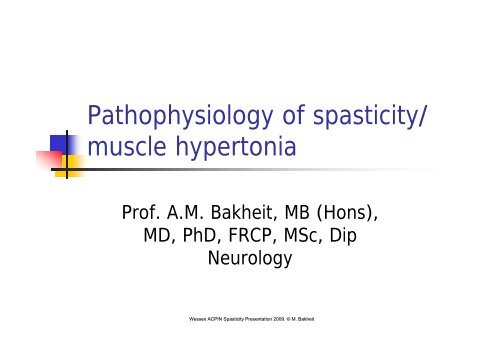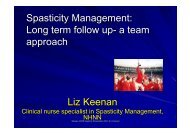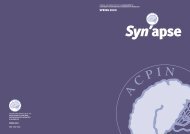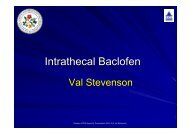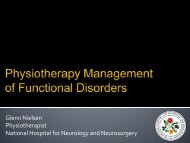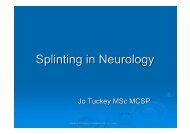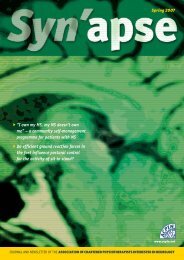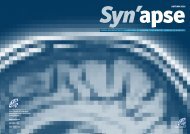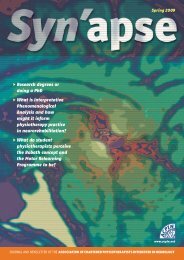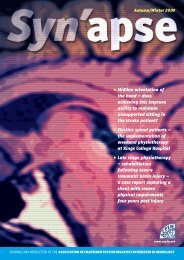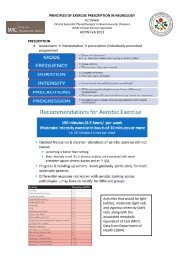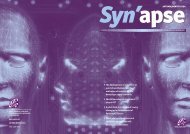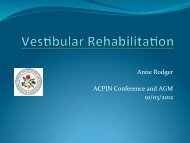Pathophysiology of spasticity/ muscle hypertonia - acpin
Pathophysiology of spasticity/ muscle hypertonia - acpin
Pathophysiology of spasticity/ muscle hypertonia - acpin
You also want an ePaper? Increase the reach of your titles
YUMPU automatically turns print PDFs into web optimized ePapers that Google loves.
<strong>Pathophysiology</strong> <strong>of</strong> <strong>spasticity</strong>/<br />
<strong>muscle</strong> <strong>hypertonia</strong><br />
Pr<strong>of</strong>. A.M. Bakheit, MB (Hons),<br />
MD, PhD, FRCP, MSc, Dip<br />
Neurology<br />
Wessex ACPIN Spasticity Presentation 2009. © M. Bakheit
Overview <strong>of</strong> presentation<br />
• Control <strong>of</strong> <strong>muscle</strong> tone<br />
• Effects <strong>of</strong> UMN lesions<br />
• Spasticity versus <strong>hypertonia</strong><br />
• Significance <strong>of</strong> maladaptive changes in<br />
spastic <strong>muscle</strong><br />
Wessex ACPIN Spasticity Presentation 2009. © M. Bakheit
The regulation <strong>of</strong> <strong>muscle</strong> tone<br />
Peripheral mechanisms <strong>of</strong> regulation –<br />
spindle, Golgi organ, Renshaw cells, fusiform<br />
neurones<br />
• Supra spinal control<br />
Wessex ACPIN Spasticity Presentation 2009. © M. Bakheit
Supra spinal control <strong>of</strong> <strong>muscle</strong><br />
tone<br />
Tract<br />
Rubrospinal<br />
Tectospinal<br />
Vestibulospinal<br />
Lat. reticulospinal<br />
Vent. reticulospinal<br />
Function<br />
Postural tone<br />
Head movements/ vision<br />
Facilitates tone/ head movements<br />
Inhibits tone in limbs & trunk<br />
Facilitates tone in limbs & trunk<br />
Wessex ACPIN Spasticity Presentation 2009. © M. Bakheit
Effects <strong>of</strong> upper motor<br />
neurone lesions<br />
• On <strong>muscle</strong> strength - Muscle weakness,<br />
fatigability, loss <strong>of</strong> dexterity<br />
• On tone – enhanced stretch reflex, agonistantagonist<br />
co-activation, reflex restraint <strong>of</strong> voluntary<br />
movement<br />
Wessex ACPIN Spasticity Presentation 2009. © M. Bakheit
Spasticity versus <strong>hypertonia</strong><br />
• Lance’s definition <strong>of</strong> <strong>spasticity</strong> – “…<br />
velocity dependent increase in the tonic stretch<br />
reflex …”<br />
• Phenomena associated with <strong>spasticity</strong> –<br />
flexor & extensor spasms, associated reactions,<br />
spastic dystonia, pain<br />
• Maladaptive changes in spastic <strong>muscle</strong><br />
Wessex ACPIN Spasticity Presentation 2009. © M. Bakheit
Maladaptive changes in spastic<br />
<strong>muscle</strong><br />
• Thixotropy<br />
• Visco-elastic properties <strong>of</strong> <strong>muscle</strong><br />
• Muscle fibre composition<br />
Wessex ACPIN Spasticity Presentation 2009. © M. Bakheit
Changes in <strong>muscle</strong> fibre<br />
composition<br />
Type<br />
I (red)<br />
IIB (white)<br />
IIA (white)<br />
“New fibre”<br />
velocity<br />
Slow<br />
Fast<br />
Fast<br />
Slow<br />
Fatigability<br />
Fatigable<br />
Fatigable<br />
Fatigue-resistant<br />
Fatigable<br />
Wessex ACPIN Spasticity Presentation 2009. © M. Bakheit
Clinical relevance <strong>of</strong> <strong>muscle</strong><br />
changes<br />
• Impairment level assessment<br />
• Treatment <strong>of</strong> <strong>spasticity</strong>/ <strong>hypertonia</strong><br />
Wessex ACPIN Spasticity Presentation 2009. © M. Bakheit
Conclusions<br />
• “Pure” <strong>spasticity</strong> is uncommon<br />
• Need for standardisation <strong>of</strong> assessment<br />
• Importance <strong>of</strong> early treatment/<br />
prevention <strong>of</strong> maladaptive changes<br />
• Implications for future research<br />
Wessex ACPIN Spasticity Presentation 2009. © M. Bakheit


